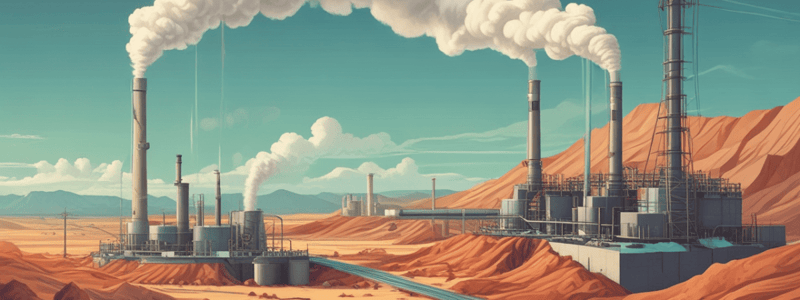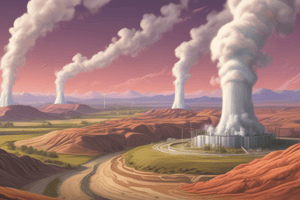Podcast
Questions and Answers
Where is geothermal energy often located?
Where is geothermal energy often located?
- Near the Earth's core
- Near the planet's surface
- Near the North Pole
- Near tectonic plates (correct)
What is one of the primary uses of geothermal energy?
What is one of the primary uses of geothermal energy?
- Generating electricity (correct)
- Irrigating crops
- Cooling buildings
- Powering vehicles
How hot does the steam need to be to generate electricity from geothermal sources?
How hot does the steam need to be to generate electricity from geothermal sources?
- Between 100 and 200 degrees Fahrenheit
- Between 300 and 700 degrees Fahrenheit (correct)
- Between 50 and 100 degrees Celsius
- Above 1000 degrees Kelvin
What was one of the uses of hot springs in ancient Greece and Rome?
What was one of the uses of hot springs in ancient Greece and Rome?
What is an advantage of heating a building using geothermal energy?
What is an advantage of heating a building using geothermal energy?
What is a unique advantage of geothermal energy compared to other renewable resources?
What is a unique advantage of geothermal energy compared to other renewable resources?
What is the primary source of heat for geothermal energy?
What is the primary source of heat for geothermal energy?
What is the main difference between dry steam and flash steam geothermal power plants?
What is the main difference between dry steam and flash steam geothermal power plants?
What is a major drawback of building a geothermal power plant?
What is a major drawback of building a geothermal power plant?
What is the primary purpose of binary cycle geothermal power plants?
What is the primary purpose of binary cycle geothermal power plants?
What is a limitation of geothermal energy in terms of its accessibility?
What is a limitation of geothermal energy in terms of its accessibility?
What is the main difference between geothermal power plants and geothermal heat pumps?
What is the main difference between geothermal power plants and geothermal heat pumps?
What is an environmental concern associated with geothermal power plants?
What is an environmental concern associated with geothermal power plants?
What is an example of a natural geothermal energy source?
What is an example of a natural geothermal energy source?
How long do geothermal heat pumps typically last?
How long do geothermal heat pumps typically last?
Flashcards are hidden until you start studying
Study Notes
What is Geothermal Energy?
- Geothermal energy is heat energy located under the Earth's surface, often near tectonic plates.
- This energy is carried to the surface and used for heat and electricity.
- Some heat is generated from the radioactive decay of materials in the Earth's core, and some is a byproduct of the planet's formation process.
History of Geothermal Energy
- Humans have used geothermal energy for at least 10,000 years, with evidence of its use found in North America, Ancient Greece, and Rome.
- Hot springs were used for healing, cooking, and escaping harsh weather, as well as for heating buildings.
Uses of Geothermal Energy
- The two primary uses of geothermal energy are for heating and generating electricity.
- Geothermal heat pumps can directly heat and cool buildings using liquid cooled and heated beneath the Earth's surface.
- Direct heat can be generated from geothermal heat pumps or by pumping hot water from hot springs to warm buildings.
- Generating electricity requires steam from geothermal sources, which is used to rotate a turbine and power an electricity generator.
Is Geothermal Energy Renewable?
- Yes, geothermal energy is renewable, as heat is constantly being produced at the Earth's core.
- However, individual geothermal plants can become cold if the heat is used more quickly than it can be replenished.
Geothermal Power Plants
- Geothermal power plants use steam from heated water underground to generate electricity.
- The three main types of geothermal power plants are:
- Dry Steam Plant: uses existing steam underground to generate electricity.
- Flash Steam Plant: generates steam by pumping high-temperature water into a low-pressure area.
- Binary Cycle Plant: conserves water while generating steam by using an organic liquid with a lower boiling point than water.
Geothermal Pumps
- Geothermal heat pumps operate on a smaller scale, used for heating and cooling buildings.
- Water or another liquid is piped underground, where it is either heated in the winter or cooled in the summer.
- Geothermal heat pumps generally last for 20-25 years, 5-10 years longer than conventional heat systems.
Geothermal Energy: Pros and Cons
Advantages of Geothermal Energy
- Renewable: heat energy is constantly renewed as long as the Earth is inhabitable.
- Clean: water vapor is usually the only emission, making it great for sustainability and carbon concerns.
- Stable: does not require wind or sunlight to operate and is unaffected by seasonal changes.
- Cost-effective: cheaper than fossil fuels, with smaller land and resource requirements.
- Adaptable: can be used for small or large applications, and adapts to various conditions and requirements.
Disadvantages of Geothermal Energy
- Can cause localized earthquakes due to injecting water into the Earth.
- Power plants can cause the ground to slowly sink as reservoirs beneath are disturbed.
- Limited location: generally limited to areas near tectonic plates.
- High initial costs: starting a geothermal power plant can be expensive, making it inaccessible to many developing countries.
- Environmental concerns: can acquire toxic chemicals like mercury and arsenic from the water being pumped underground.
Geothermal Energy Examples
- Natural examples: geysers, hot springs, lava flows, fumaroles.
- Manmade examples: geothermal heated homes, geothermal power plants.
Studying That Suits You
Use AI to generate personalized quizzes and flashcards to suit your learning preferences.




